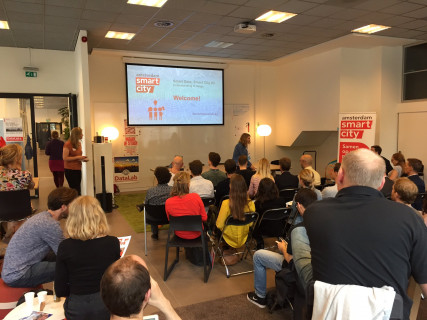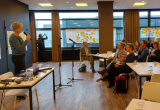The faculty Urban Technology of the Amsterdam University of Applied Sciences (AUAS or HvA) has a ‘data lab without data’. How does this work? Amsterdam Smart City’s partner AUAS, elaborated on their research for the city at Datalab on the 18th of May.
The faculty of Urban Technology of the Amsterdam University of Applied Sciences (AUAS or HvA) has a ‘data lab without data’. How does this work? Amsterdam Smart City’s partner AUAS, elaborated on their research for the city at Datalab on the 18th of May.
Urban Technology focuses on technical innovation in the city. Research is mostly done in the fields of Energy, Climate, Logistics and the Public Space. Nanda Piersma, senior researcher Big Data at the AUAS kicks off the meeting by explaining the urban analytics: ‘Our research group is basically a data lab without data. Others have the data and we just want to tap into it. That is why we work with a lot of companies, municipalities and foundations. After collecting the data, students research what happened, why this happened and make predictions for the future.’
Data mining and the city
How does this work in practice? Nanda explains two cases. For example, the AUAS conducted research on the use of electric vehicles’ charging poles. Currently there are around 2000 poles in use in Amsterdam. The AUAS distinguished different patterns in the usage of these poles: ‘pillow chargers’ charge at night and visitors charge their cars during the day. Visualizing the data per district shows a massive rise of the use of the charging poles in the Nieuw-West area in the autumn of 2014. What happened? ‘At that moment, electric taxis started driving from and to the airport’, Nanda explains. ‘It became clear that a lot of taxi drivers live in Nieuw-West. We warned the city beforehand and because of this, the municipality was able to place extra charging poles in this area.’
The next example of weighing the amount of domestic waste in containers evoked some questions. Data helps to predict when the container is full or empty, however the audience was surprised that the researchers didn’t use sensors for this. Nanda: ‘Sensors are very valuable, but these weren’t
yet available at that time. And besides, 80% of the waste stream in containers was predictable by data analysis, so why buy expensive sensors for that?’
De Gezonde Stad
De Gezonde Stad (‘the Healthy City’) develops projects to make Amsterdam fit for the future in association with companies and citizens. They teamed up with AUAS to streamline their data. More accurate and real time data helps to better define their focal points. De Gezonde Stad uses the data to understand how to activate citizens and make citizens aware of sustainable city development.
Justin Bieber
In the coming months, the AUAS has room for around thirty cases. Companies, foundations and governments can apply and students will help them with their data related questions. Someone in the audience asked if the AUAS is looking for more students within the workgroup. Nanda: ‘Our work groups are packed and extremely popular. Once registration is open, the group fills like a concert of Justin Bieber. Sold out in a few minutes.’ Right now there is a capacity of 40 students. In the coming year this amount will expand to 80 students. ‘We will make Amsterdam our data lab’.
Discussion
The presentation led to a lively discussion about the possibilities of data and the opportunities of Datalab and their open data platform. One of the challenges seems to be bringing together the questions people in the city have and
which data(sets) could be useful. Amsterdam Smart City or the HvA Smart City Academy are investigating if they can play a role in this matchmaking!
Do you want more information, do you want to share your data and help students or do you have a specific case for the students? Please let us know by responding to this post. Then we will get in touch!





